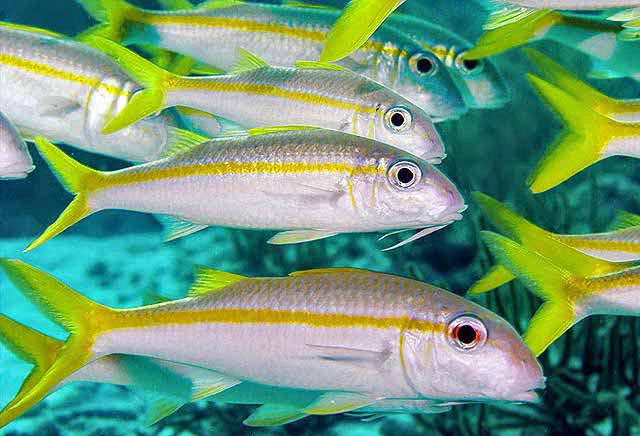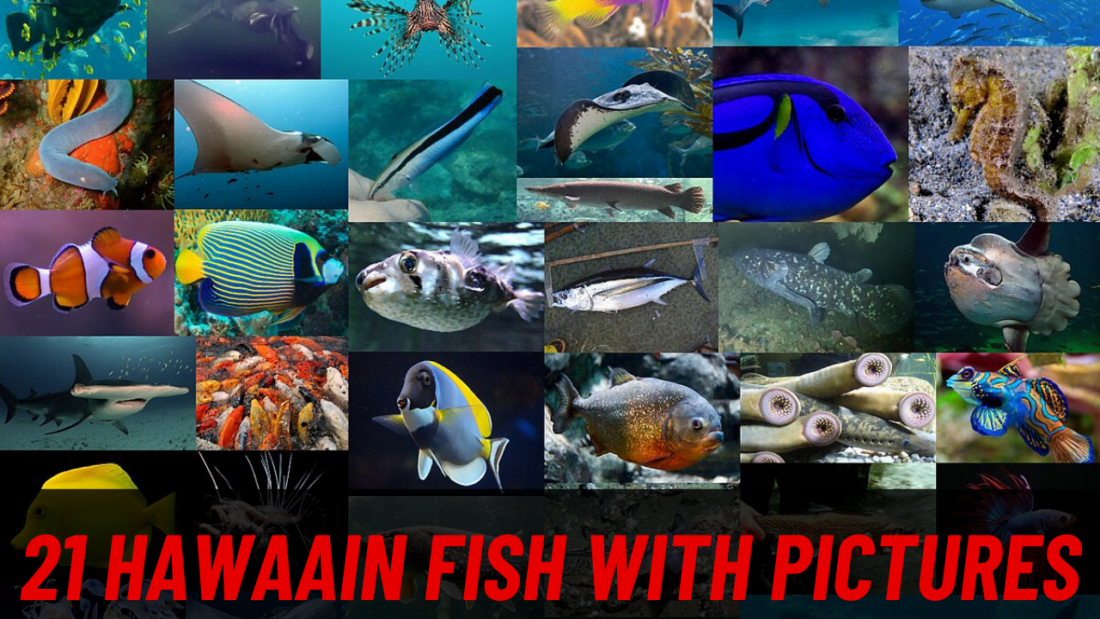Aloha fish fans! The warm, clear waters of Hawaii are home to some of the most fascinating fish species in the world. From the shallow reefs to the deep blue expanses, these waters boast some extraordinary fish. According to the Bishop Museum, there are more than 1100 fish species found in Hawaii. We have picked the top 21 incredible Hawaiian fish with pictures. If you’re lucky enough to go snorkeling in Hawaii, keep an eye out for them:
21 incredible Hawaiian fish with pictures
1. Reef Triggerfish (Humuhumunukunukuapuaa): Hawaii’s State Fish
- Identification: Parallelogram-shaped body with a blue mustache. Blue-black striped cap, and a bright gold outlined ‘V’ before the fan-like tail.
- Pronunciation: Humuhumunukunukuapuaa (hoo-moo-hoo-moo-noo-koo-noo-koo-ah-poo-ah-ah)

One of the most iconic Hawaiian fish has to be the Humuhumunukunukuapua’a, aka the triggerfish or reef triggerfish. It is renowned for having the longest name of any species. This quirky reef dweller gets its very long name from the Hawaiian language, which translates to something like “fish with a nose like a pig.” When you see one up close, you’ll immediately understand why! These striking fish have an elongated snout that does indeed resemble a little piggy nose. They swim using their belly and back fins. Reef Triggerfish are found throughout shallow waters, coral reefs and rocky areas. When threatened, they make a loud grunting noise by grinding their teeth. Unique shape, dazzling black-yellow color and weird name makes the Humuhumunukunukuapua’a unmistakable. It has been the Hawaiian state fish since 1984
2. Trumpetfish (Nunu)
- Idntification: Trumpet fish have a tubular body shape with a small mouth at the end of a long snout. Long, straight body shape has earned it the common name “stickfish. Their color varies from gray to green or yellow, with horizontal and vertical stripes for camouflage.
- Pronunciation: Nunu (noo-noo)

The Trumpet fish is a master of camouflage as they are able to change color to match its environment. Growing up to two feet in length, their slender form resembles that of a trumpet, hence their name. They are so thin that they can be nearly invisible from certain angles. Their color varies from shades of brown and green to vibrant yellows and oranges, allowing them to mimic the coral reefs, seagrass beds, and rocky crevices in which they dwell. Trumpet fish are ambush predators that wait motionless until small prey fish come within range, then quickly suck them into their small mouths.
3. Moorish Idol (Kihikihi)
- Identification: Distinctively shaped with a compressed, disc-like body. Long dorsal fin extends from the top of the head almost to the tail. Around 6-8 inches in length. Yellow in color with white vertical stripes and a black vertical band near the tail.
- Pronunciation: Kihikihi (kee-hee-kee-hee). So the name references the sound or whistling noise that the Moorish idol makes.

Moorish Idol commonly seen while snorkeling in any Hawaiian Island. In the film ‘Finding Nemo’ the popular character named ‘Gill’ was actually a Moorish Idol. It is a social and active species, often found in pairs or small groups as they gracefully navigate the coral reefs. These curious fish are not shy and may approach divers and snorkelers, offering an up-close glimpse. Moorish Idols are herbivorous, they feed on a diet of algae and small invertebrates found on the reef.
4. Hawaii Yellow Tang (‘Lau’ī pala)
- Identification: Laterally compressed, oval-disc-shaped body. A long snout or beak-like mouth protrudes outward. The tail fin of a crescent-shaped. Pectoral fins are relatively small. They are round 8 inches in length.
- Pronunciation: Lau’ī pala (Lah-oo-ee pah-lah): Lau’ī Means “tang” and Pala- Means “yellow” in Hawaiian

Yellow Tang fish is one of the most popular and iconic reef fish in Hawaiian waters due to its brilliant yellow coloration. It has featured in “Finding Nemo” as the character Bubbles. Gets its name from its distinctive tang or knife-like shape. They Swims in schools and aggregates near corals and ledges. They are herbivorous, feeding on various types of algae that grow on the reef structures. Its bright yellow color serves as a warning to predators that it has toxic flesh from the types of algae it consumes. Yellow Tang is true ambassador of Hawaii’s underwater paradise. It featured extensively in Hawaiian artwork, souvenirs and ocean-themed decor.
5. Longnose Butterflyfish (Lauwiliwili nukunuku’oi’oi)
- Identification: Long, tubular snout or “nose” which can be nearly as long as half its body. Oval, compressed body shape. Overall bright yellow color. Black stripe running vertically through the eye. White edges on the dorsal and anal fins.
- Pronunciation: Lauwiliwili nukunuku’oi’oi (Lau-wee-lee-wee-lee Noo-koo-noo-koo-oi-oi) Say that three times fast!

Longnose Butterflyfish is highly valued for its beauty and is a popular sight for snorkelers in Hawaii. It is found in solitarily or in mated pairs on coral reefs and rocky areas. It hovers above the reef using its pectoral fins to remain stationary. It uses its long snout to feed on coral polyps, small crustaceans, and other invertebrates. The fish is generally shy and reclusive. Most abundant around the northwestern Hawaiian islands like Midway.
6. Hawaiian Lionfish (Honu Pinao)
- Identification: Member of the scorpionfish family. Around 12 inches long. Reddish-brown or maroon body covered in vertical white stripes. Shaggy, elaborate reddish-brown fins with black spots. Fleshy tentacles protrude above the eyes and below the mouth. Elongated dorsal spines tipped with venom glands
- Pronunciation: Honu Pinao (Ho-noo pee-now) which literally means- Dragonfly

There are more than 25 species of Lionfish that inhabit Hawaiian waters. They are also called Turkeyfish. According to The University of Michigan, Museum of Zoology-Hawaiian Turkeyfish are endemic Hawaiian reef fish. They are more commonly found in caves and beneath ledges during the day, becoming more active in the reef at night. Hawaiian Lionfish reside in less than 200m of water and stay fairly close to shore. It is an ambush predator that corners and swallows small fish and shrimp whole. See but never touch them! Their venomous glands can produce very painful stings.
7. Parrotfish (Uhu):
- Identification: Their bright colors, Parrot-like beak, and constant grazing activity make them very recognizable Hawaiian reef fish.
- Pronunciation: Uhu (oo-hoo)

Parrotfish are known for their vibrant and striking colors. They come in a variety of colors, including shades of blue, green, yellow, and red. There are seven different types of parrotfish roaming the Hawaiian waters— stories, yellow bar, spectacled, bullet head, regal, pale nose, and red lip. You can easily find them in coral reefs, rocky coasts, and seagrass beds. According to The University of Hawaiʻi at Mānoa– “Scientists estimate that up to 70% of the sand on white sandy beaches in Hawaii has been excreted by parrotfish. A large adult parrotfish can excrete over a ton of sand per year.” In Hawaiian culture, the Uhu is no ordinary fish. It’s like the supernatural parent of all fish species.
8. Hawaiian cleaner wrasse (Hīnālea)
- Identification: Usually around 4-6 inches long Slim, elongated body shape. A yellow or orange body with blue markings on its head and fins. Large protruding lips.
- Pronunciation: Hīnālea (hee-nah-lay-ah) means playful cleaner

Its Hawaiian name perfectly captures its lively actions. The Cleaner Wrasse is known for its unique cleaning behavior. It sets up cleaning stations on the reef, where other fish come to have parasites, dead skin, and other debris removed from their bodies. Cleaner Wrasses are social fish that live in small groups or harems. They found on shallow coral reefs and rocky areas around the main Hawaiian islands. It prefers areas with good water flow.
9. Achilles Tang (Pākuʻikuʻi)
- Identification: It has a deep, dark oval body with a bright orange band that runs vertically across its body. Yellow tailfin with black outer edge. White base and black markings near tail fin. known for its elongated snout and sharp spines.
- Pronunciation: Pākuikui (pah-koo-ee-koo-ee)

The Achilles Tang has a distinctive and eye-catching appearance. They are commonly found on coral reefs and rocky areas around the main Hawaiian Islands. Prefers exposed outer reef slopes and channels. According to Hawaii Wildlife Fund– Recent surveys have indicated a significant decline in this species, beginning in the early 2000s. Experts recently described this species as “dangerously depleted”. Pākuʻikuʻi is a popular fish for both subsistence fisheries and the aquarium trade. Because pākuʻikuʻi are typically found in very shallow water and tend to be territorial, they’re a relatively easy target compared to other types of surgeonfish.
10. Bluestripe Snapper (Ta’ape)
- Identification: Overall yellow body color. Five distinctive bright blue horizontal stripes run along each side. Slender, streamlined body shape typical of snappers. Yellow caudal fin with a broad blue edge. Usually around 12-16 inches long
- Pronunciation: Ta’ape (Tah-AH-peh)

Bluestripe Snapper is easily identified by its lemon-yellow skin and electric-blue stripes. These snappers are usually seen in small groups or schools, and they are more active during the daytime. They are carnivorous and feed on a variety of small fish, crustaceans. According to the Conservation International: Taʻape are an invasive species, competing with native fish and causing economic losses for local fishers.
11. Yellowfin Goatfish (weke ‘ula)
- Identification: It has a slender, elongated body with mouth located at the bottom of the head. the flanks and belly are whitish. Its fins are a vibrant yellow. Yellow longitudinal lines runs along its sides. Average 12-14 inches in length.
- Pronunciation: weke ‘ula (way-kay-ooh-lah)

Yellowfin goatfish is a species of goatfish known to the native Hawaiians as weke ‘ula. They have two long, thin barbels (Mustache) around chin area. These barbels are used to help the fish detect prey and food sources in the sandy/muddy bottom areas where they feed. This mustache-like feature is found in all goatfish species, that is why they are called “goatfish. During the day, Yellowfin Goatfish roam in large group. At night, they feed on crustaceans or worms. They have mild, white flesh that is considered good eating.
12. Saddleback Wrasse (Hīnālea Lauwili)
- Identification: Bright colorful fish with a stout, laterally compressed body. Adults have a dark brown or black “saddleback” marking across the top of their body. Around 8 inches in length
- Pronunciation: Hīnālea Lauwili (hee-nah-lay-ah La-ah-veh-lah)

One of the most common reef fish found in Hawaii. Saddleback Wrasses are endemic to Hawaii and are also found around Johnston Atoll. As juveniles, they act as “cleaners”, picking parasites from larger fish or animals. As they mature, they scavenge for worms, shells, mollusks, shrimps, and other crustaceans. Popular in reef aquariums for their bright colors and active nature.
13. Convict Tang (Manini)
- Identification: Body is oval-shaped and laterally compressed. A pointed snout and a terminal mouth with thick lips. Adults have alternating six black vertical bars/stripes on their white-yellow bodies. The first black stripe is oblique and passes through the eye.
- Pronunciation: Manini (mah-nee-nee)

Convict Tang is a highly recognizable and beloved reef fish. They are commonly found in shallow, rocky areas and coral reefs throughout the Hawaiian Islands. They are often seen in small groups, or in large schools. They are primarily herbivorous, grazing on algae and plants. Manini featured prominently in Hawaiian legends, songs, and sayings. The striped pattern of the manini is used in Hawaiian designs and artwork.
14. Hawaiian Sergeant (Mamo)
- Identification: Adults have a deep blue-black body with yellowish fins and belly. Black “mask” marking around the eyes resembling Hawaiian war helmets. Around 9 inches in length
- Pronunciation: Mamo (mah-moh)

The Green Damselfish aka Hawaiian Sergeant Major found in the vicinity of the Hawaiian Islands, Midway Island, and Johnston Atoll. They feed on plankton, seaweed, and other marine organisms. Found singly or in small groups around coral reefs. Male mamo make a nest site on a rock surface to which they attract females for breeding. Females lay thousands of purple eggs and the male protects the eggs from predators. Try not to touch the mamo as it doesn’t like snorkelers and divers to breach its area.
15. Hawaiian bigeye ( āweoweo)
- Identification: Bigeyes are red or silvery fishes with narrow and compressed bodies. They have huge eyes and a forked tail.
- Pronunciation: āweoweo (Aah-wee-o-wee-oh) means glowing red.

According to Hawaifishes.com– There are two shallow-water species in Hawaii both quite similar in appearance. The Hawaiian Bigeye is endemic, while the Common Bigeye also called Glass-Eye or Goggle-Eye, occurs throughout the Indo-Pacific. Both species typically remain under ledges and in caves by day, seemingly asleep. At this time they are easy to approach and sometimes even easy to touch. At night they emerge to feed on planktonic animals high in the water column. Interestingly, due to their highly reflective eyes fishermen often use flashlights to spot them at night.
16. Raccoon Butterflyfish (kīkākapu)
- Identification: Distinctive black mask-like marking around the eyes resembling a raccoon. Yellow body with vertical black bars. Darker on the upper half of the body.
- Pronunciation: Kikakapu (kee-kah-kah-poo)

Raccoon Butterflyfish are found in groups around coral reefs at depths of 10-60 feet. It is a peaceful fish so it’s a very popular aquarium fish due to its striking pattern. They are omnivorous, feeding on coral polyps, algae, and small invertebrates. mostly active during night. In Hawaii, several butterflyfish species are known as kikakapu.
17. Great Barracuda (kaku)
- Identification: Long, cylindrical body with a large underslung jaw filled with razor-sharp teeth. Dark green or gray on top, fading to white below. Grows up to 5.5 feet in length.
- Pronunciation: kaku (kah-koo)

Great barracudas are large fish and one of the largest species of the Barracudas. They are voracious predators and hunt by ambush. They feed on smaller fish, such as reef fish, as well as squid and shrimp. They are opportunistic hunters and use their speed and sharp teeth to capture and consume their prey. These predatory fish are highly adaptable and are frequently spotted near Kauai’s coastline. Great barracudas are a notable attraction for snorkelers and divers in Hawaii.
18. Moray Eel (Puhi)
- Identification: Long, snake-like bodies with large gaping jaws filled with sharp teeth. Mottled brown, green, or yellow color to camouflage in reef. They can grow up to 8 feet long
- Pronunciation: Puhi (poo-hee)

Some species of moray eels, such as the ricefield eel, can change their sex during their lifetime. They start as males and later transform into females in a process called sequential hermaphroditism. Moray Eels have a second set of jaws—called pharyngeal jaws—located in their throat. These inner jaws help them grab prey and pull it down their throat after the main jaws have captured it, much like a scene from the movie “Alien.” They hide in holes and crevices during the day, emerging at night to hunt. It is an important predators that help control reef fish populations. Moray Eels have been considered the guardians or ‘aumakua (spiritual ancestors) of fishermen in Hawaii. They are not a threat to snorkelers and will only be aggressive when food is involved. Do not tease them. Some species are popular in the aquarium trade.
19. Yellowtail Coris (Roi)
- Identification: Elongated body colored. Yellow on the front half and blue on the rear half
- Pronunciation: Roi (roy)

Yellowtail Coris wrasse, aka Red Coris wrasse, is sometimes called the tomato or clown wrasse. As juveniles, Yellowtail Coris Wrasses start as small reddish-orange fish with black-lined white spots along their backs. As they age, these red scales develop stripes of Blue and orange. Male Yellowtail Coris Wrasses are often slightly larger and brighter than the females. Found individually or in small groups around coral reefs. Feeds on small invertebrates and algae.
20. Spotted Dolphin (kiko)
- Identification: A small species of dolphins, typically around 6 feet in length. Slender body with a long distinct beak, Light gray belly and darker gray/bluish on top.
- Pronunciation: kiko (kee-ko)

Hawaiian name for dolphin is Nai’a. Spotted Dolphins are the most common dolphins seen in Hawaii. They travel in large pods that can number in the hundreds. Feed on fish, squid, and crustaceans. According to NOAA– In the Hawaiian archipelago, there are genetically distinct populations of pantropical spotted dolphins found between Hawaiߵi Island, Maui Nui, Oߵahu, and offshore. Animals from each population can travel 120 to 300 miles offshore, but they are generally found closer to the islands. Spinner and Bottlenose are two common dolphins found in Hawaii other than the Spotted.
21. Manta ray (Hāhālua)
- Identification: Flat body with triangular pectoral fins resembling wings, Mouth located at the front of the body, used to filter plankton from the water.
- Pronunciation: Hāhālua( ha-ha-loo-aah) means – two breaths

Manta rays, also known as “Devil rays,” are large rays belonging to the genus Mobula. ‘Manta’ means blanket or cloak in Spanish. Despite their size, they are docile, harmless, and curious creatures. Their nightly ritual involves feasting on plankton, which makes the Big Island an ideal location for their encounters. The Kona Coast of Big Island -especially at night, is the number one place to see manta rays while snorkeling in Hawaii. Manta rays are filter feeders, which means they consume large amounts of plankton and small fish by filtering them out of the water.
Conclusion
So friends! seeing these beautiful Hawaiian fish with your own eyes while snorkeling is an unforgettable experience. From the famous Humuhumunukunukuāpua’a to the vibrant Pākuikui, you’ll be awestruck by the diversity of fish in the Aloha state. So send us your pictures with any of these beautiful fish and tell us what’s your favorite Hawaiian fish.

